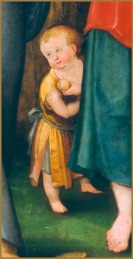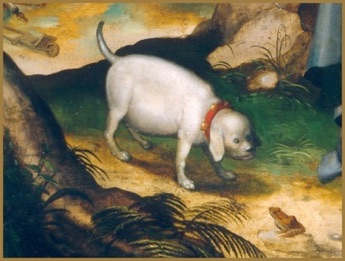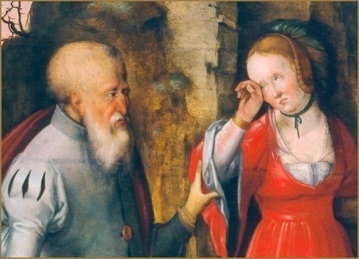Pieter Cornelisz Kunst after Lucas van Leyden (1493?-1533)
Low Countries ca 1530
Hagar’s exile
Abraham, patriarch of both Jews and Arabs, and his wife Sara were still childless at an advanced age, much to their regret. It was customary at the time to keep slaves, including for the purposes of child-bearing, and thus it was that Abraham turned to Hagar -with his wifes consent!- his servant. Hagar bore Abraham a son, Ishmael. Shortly after that, three angels appeared to Abraham and Sara to proclaim the forthcoming bearing of a child by Sara. In due time, Isaac, a healthy son was born. Isaac was bullied by Ishmael in such a way that Abraham thought it would be better to send both him and Hagar away. The panel shows the moment when Abraham makes clear to Hagar that she and her son are no longer welcome. The Scripture recounts how they are sent forth into the desert, but this Dutch painting shows not a desert, but rather a lush green landscape. The water jar that Hagar takes doesnt last very long, and Hagar is about to give up hope. However, the archangel Michael appears before her and shows her a well - we see this depicted at the right side in the background. This scene is often represented in paintings of the time. The main characters are dressed in fantasy clothes: this is how people in the sixteenth century thought eastern fashion would have been in the time before Christ! A beautiful and funny moment in the painting is the astonishment with which the little fat dog approaches the toad.
Paneel
Kunst, Pieter Cornelisz
Nederland, Leiden?
Verdrijving van Hagar
ca. 1530
De voorstelling is ontleend aan een prent van Lucas van Leyden (1489?-1533)
Door mevr. Brenninkmeyer-de Ploeg mogelijk toegeschreven aan Pieter Cornelisz Kunst uit Leiden.
De bijbelse aartsvader Abraham en zijn vrouw Sara hadden tot hun grote verdriet geen kinderen. Om zich toch op de een of andere manier van nageslacht te verzekeren wendde eerstgenoemde zich, op aanraden overigens van zijn echtgenote, tot Sara’s dienstmaagd Hagar. Deze baarde Abraham een eerste zoon, die Ismaël genoemd werd. Niet lang daarna voorspelden drie engelen aan Abraham dat zijn vrouw, hoewel bejaard, toch een kind zou krijgen. Na de geboorte van deze gezonde zoon, Isaak, bracht Sara Abraham ertoe Hagar en haar kind te verstoten. Het paneel laat zien hoe de aartsvader deze hardvochtige mededeling doet aan de moeder van zijn eerstgeborene. Niets in het nogal Nederlandse landschap wijst erop dat Hagar en Ismaël de woestijn in gestuurd worden, maar dat is in de bijbel wel het geval. De waterkruik die Abraham hun heeft meegegeven is snel leeg en Hagar geeft de moed op. Gelukkig is redding immer nabij als de nood het hoogst is: de engel Michaël verschijnt en wijst de wanhopige vrouw een bron, een tweede verhaalmoment dat in de kunst veelvuldig werd afgebeeld. De hoofdpersonen in het verhaal, Hagar en Abraham, dragen fantasiekleding; zo moet men zich in de zestiende eeuw de Oosterse mode van ver voor Christus hebben voorgesteld. Een prachtig detail in dit schilderij is de samenspraak tussen het hondje en de kikker links onderaan.







